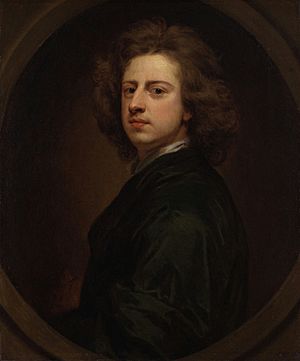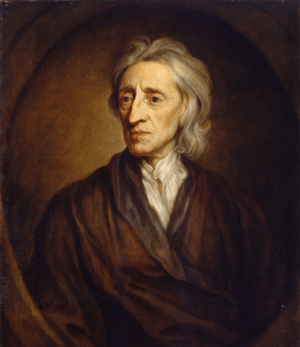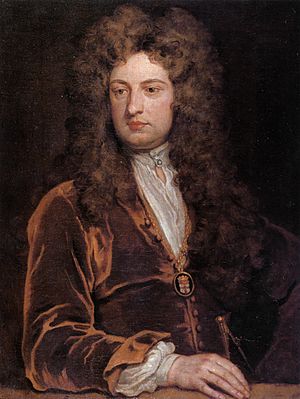Godfrey Kneller facts for kids
Quick facts for kids
Godfrey Kneller
|
|
|---|---|

Self-Portrait, 1685, NPG London
|
|
| Born |
Gottfried Kniller
8 August 1646 |
| Died | 19 October 1723 (aged 77) |
| Nationality | German, later British |
| Occupation | Painter |
| Known for | Leading portrait painter of England |
| Spouse(s) | Susanna Grave |
| Children | Agnes Huckle |
| Relatives |
|
Sir Godfrey Kneller (born Gottfried Kniller; August 8, 1646 – October 19, 1723) was a very famous portrait painter in England. He was the top artist during the late 1600s and early 1700s. Kneller was the official painter for English and British kings and queens. He worked for rulers from King Charles II to King George I.
Some of his most important paintings include The Chinese Convert (1687). He also painted Isaac Newton four times at different points in his life. Kneller created portraits of ten European monarchs, including King Louis XIV of France. He also painted over 40 "kit-cat portraits" of members of the Kit-Cat Club. Another famous series was the ten "Hampton Court Beauties". These were portraits of important ladies at the court of King William III. This series matched a similar one of ten ladies from Charles II's court painted by Sir Peter Lely. Lely was the court painter before Kneller.
Contents
Early Life and Artistic Training

Godfrey Kneller was born Gottfried Kniller in Lübeck. At that time, Lübeck was a free city in the Holy Roman Empire. His father, Zacharias Kniller, was also a portrait painter.
Kneller first studied in Leiden. Later, he became a student of famous Dutch painters. These included Ferdinand Bol and Rembrandt Harmenszoon van Rijn in Amsterdam. In the early 1670s, he traveled to Rome and Venice with his brother, Johann Zacharias Kneller. His brother was an ornamental painter. In Italy, Godfrey painted historical scenes and portraits. He worked in the studio of Carlo Maratti. After his travels, he moved to Hamburg.
Becoming a Leading Painter

Godfrey and his brother came to England in 1676. There, they gained the support of the Duke of Monmouth. Kneller was then introduced to King Charles II and painted his portrait.
In England, Kneller focused almost entirely on painting portraits. He set up a large studio that could produce many portraits quickly. He would make a quick sketch of the person's face. Then, his assistants would add details using a standard model. This was made easier because gentlemen often wore large wigs at the time. His style of portraits became very popular. It influenced other artists until the time of William Hogarth and Joshua Reynolds.
Kneller quickly became the top portrait artist in England. When Sir Peter Lely, the previous court painter, died in 1680, Kneller took his place. King Charles II appointed him as the Principal Painter in Ordinary to the Crown.
For about 20 years, from 1682 to 1702, Kneller lived in a famous area of London called Covent Garden.
Royal Recognition and Famous Works

In the 1690s, Kneller painted the "Hampton Court Beauties". These were portraits of the most glamorous ladies at the Royal Court. For this work, King William III made him a knight in 1692. In 1695, he received an honorary law degree from the University of Oxford. This was a special honor given in the presence of the king. In 1700, the Emperor Leopold I made him a Knight of the Holy Roman Empire.
Kneller also created a series of "Kit-cat" portraits. These were 48 portraits of important politicians and writers. They were all members of the Kit-Cat Club.
On May 24, 1715, King George I made him a baronet. This was a special title that made him "Sir Godfrey Kneller, 1st Baronet." From 1711 to 1716, he also led the Kneller Academy of Painting and Drawing in London. Many famous writers of the time, like John Dryden and Alexander Pope, praised his paintings.
Later Life and Legacy
Kneller married Susanna Grave on January 23, 1704, in London. She was a widow. They did not have any children together.
Kneller passed away from a fever in 1723. He was buried in Twickenham. He had been a churchwarden at St Mary's Church there. He helped with the plans to rebuild the church after its nave collapsed in 1713.
A memorial was built for Kneller in Westminster Abbey. In his will, Kneller left money to his assistant, Edward Byng. Byng also received all the drawings from Kneller's studio. Kneller's main fortune went to his grandson, Godfrey Kneller Huckle. This grandson was the son of Kneller's daughter, Agnes Huckle. He took his grandfather's last name, Kneller, to receive the inheritance.
The land where Kneller built his house in 1709 later became Kneller Hall. This building became home to the Royal Military School of Music in the mid-1800s.
|
See also
 In Spanish: Godfrey Kneller para niños
In Spanish: Godfrey Kneller para niños
- English school of painting
- Kneller Hall

